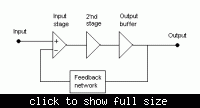Shayaan_Mustafa
Full Member level 5

OK Thank you first of all
As I am going to design 50W audio amplifier, so what things (class of amplifier, etc..) should I need for this?
If you tell me those components which are necessary in order to design 50W audio amplifier then I will start a new thread for that.
As I am going to design 50W audio amplifier, so what things (class of amplifier, etc..) should I need for this?
If you tell me those components which are necessary in order to design 50W audio amplifier then I will start a new thread for that.






